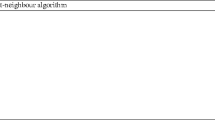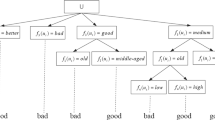Abstract
The extension theory (ET) is one of the simplest and most attractive pattern classification methods. However, it has difficulty determining the classical domain. In addition, the traditional extended relational function used in extension theory does not provide very useful summaries of asymmetrical data. This study proposes a modified extension theory (MET) to overcome these shortcomings. The MET applies the largest sphere concept to determine the range of the classical domains and incorporates the information about the data distribution when calculating the relevance of an element belonging to a set. Experimental results indicate that the MET consistently achieved better or comparable results than the traditional ET. The MET also produces a classifier with satisfactory classification accuracy compared with well-known classifiers (e.g., decision trees and k-nearest neighbor).




Similar content being viewed by others
References
Cai W (1983) The extension set and incompatibility problem. J Sci Explor 1:610–614
Chao K-H, Li C-J (2010) An intelligent maximum power point tracking method based on extension theory for PV systems. Expert Syst Appl 37:1050–1055
Duer S (2011) Qualitative evaluation of the regeneration process of a technical object in a maintenance system with an artificial neural network. Neural Comput Appl 20(5):741–752
Gao J, Lin P, Yang Y, Wang P, Zheng C (2010) Real-time removal of ocular artifacts from EEG based on independent component analysis and manifold learning. Neural Comput Appl 19(8):1217–1226
Liu M, Lo SM, Hu BQ, Zhao CM (2009) On the use of fuzzy synthetic evaluation and optimal classification for computing fire risk ranking of buildings. Neural Comput Appl 18(6):643–652
Lopez JJ, Cobos M, Aguilera E (2011) Computer-based detection and classification of flaws in citrus fruits. Neural Comput Appl 20(7):975–981
Koonce DA, Tsai S-C (2000) Using data mining to find patterns in genetic algorithm solutions to a job shop schedule. Comput Ind Eng 38:361–374
Oztekin A, Kong ZJ, Delen D (2011) Development of a structural equation modeling-based decision tree methodology for the analysis of lung transplantations. Decis Support Syst 51(1):155–166
Wang M-H (2004) Application of extension theory to vibration fault diagnosis of generator sets. IEE Proc Gener Transm Distrib 151(4):503–508
Wang M-H, Hung C-P (2003) Extension neural network and its applications. Neural Netw 16:779–784
Wang M-H, Tseng Y-F, Chen H-C, Chao K-H (2009) A novel clustering algorithm based on the extension theory and genetic algorithm. Expert Syst Appl 36:8269–8276
Ye J (2009) Application of extension theory in misfire fault diagnosis of gasoline engines. Expert Syst Appl 36:1217–1221
Yilmaz S, Arici AA, Feyzullahoglu E (2011) Surface roughness prediction in machining of cast polyamide using neural network. Neural Comput Appl 20(8):1249–1254
Author information
Authors and Affiliations
Corresponding author
Rights and permissions
About this article
Cite this article
Liu, CH. Extending extension theory for classifying data with numerical values. Neural Comput & Applic 23, 161–167 (2013). https://doi.org/10.1007/s00521-011-0795-z
Received:
Accepted:
Published:
Issue Date:
DOI: https://doi.org/10.1007/s00521-011-0795-z




